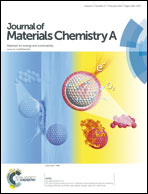A luminescent metal–organic framework demonstrating ideal detection ability for nitroaromatic explosives†
Abstract
A 3D metal–organic framework, [NH2(CH3)2]2[Cd17(L)12(μ3-H2O)4(DMF)2(H2O)2]·solvent (1), has been constructed with a π-electron rich aromatic ligand 2,4,6-tris[1-(3-carboxylphenoxy)ylmethyl]mesitylene (H3L) and d10 configuration metal ion Cd2+ under solvothermal conditions. The crystal structure reveals that complex 1 consists of hexanuclear and trinuclear cadmium building units, which are further bridged by the multicarboxylate ligands to give a (3, 6, 12)-connected topological net. This complex exhibits strong ligand originated photoluminescence emission, which is selectively sensitive to electron-deficient nitroaromatic explosives (nitrobenzene, 4-nitrotoluene, 1,4-dinitrobenzene, 1,3-dinitrobenzene and 2,4-dinitrotoluene). This property makes complex 1 a potential fluorescence sensor for these chemicals.


 Please wait while we load your content...
Please wait while we load your content...